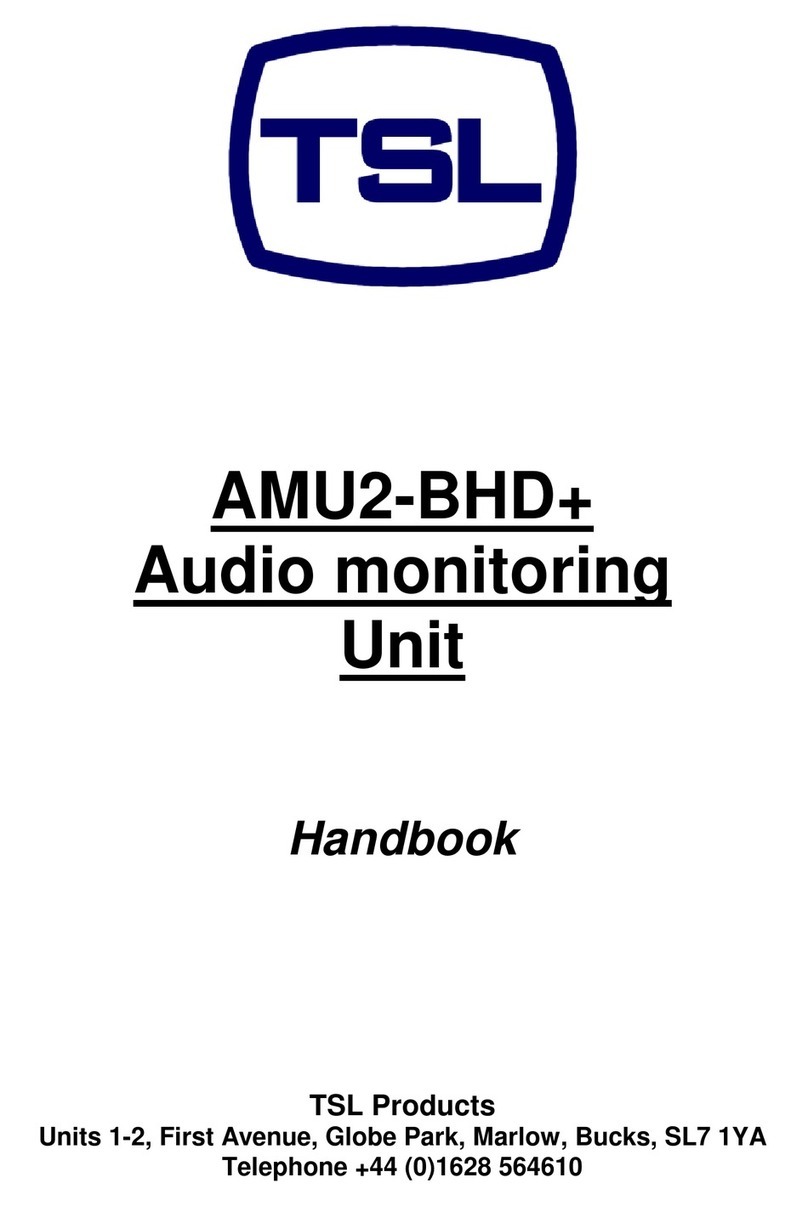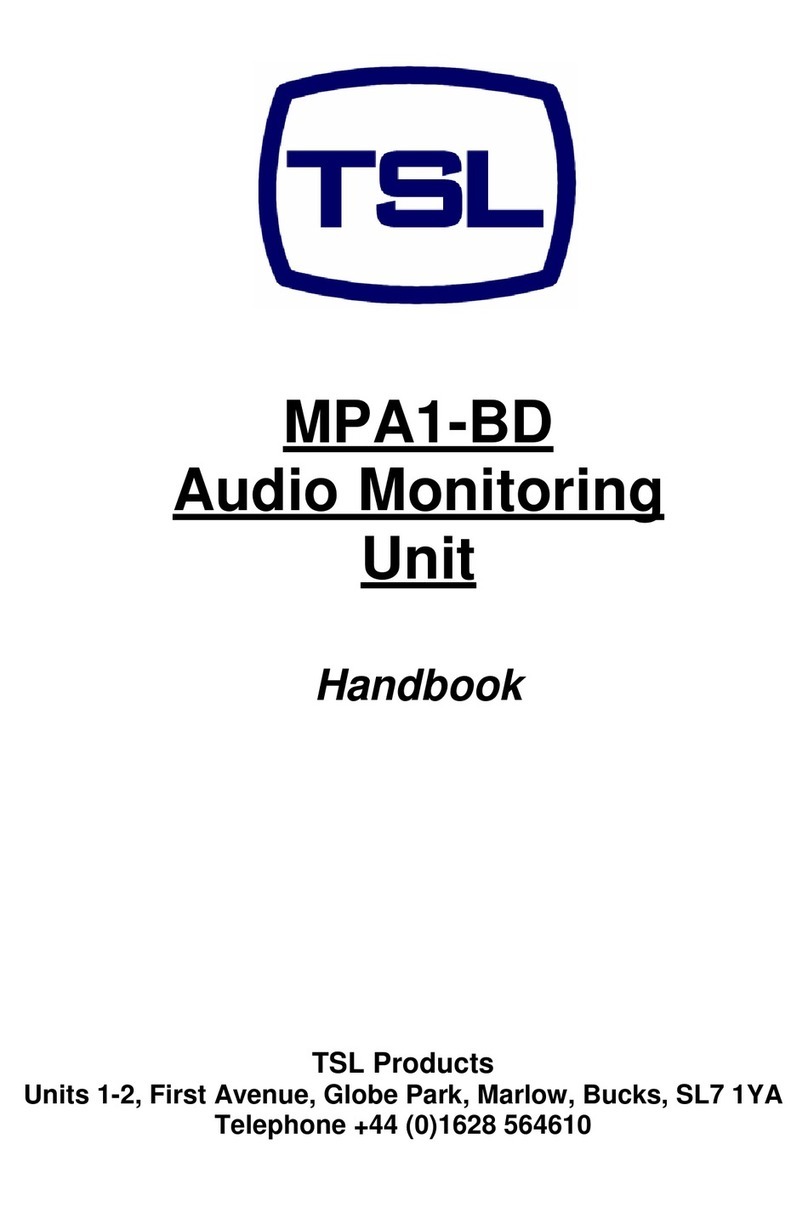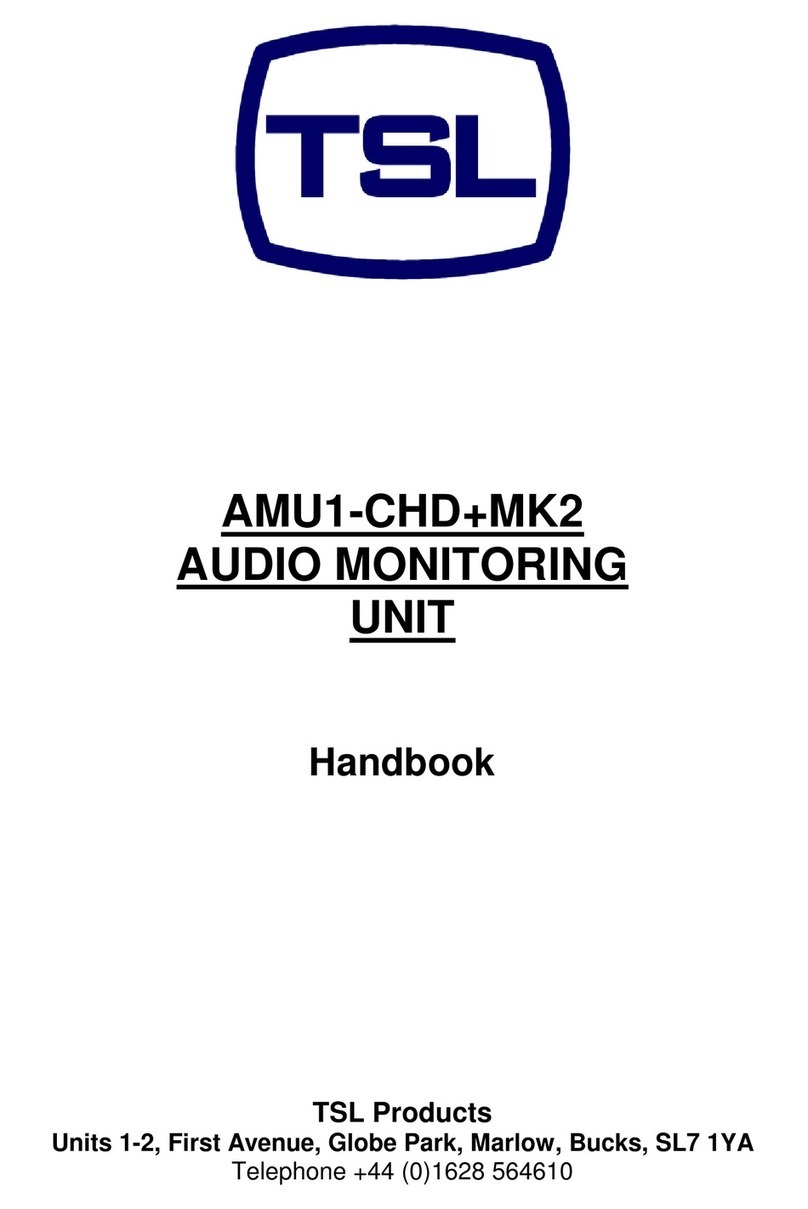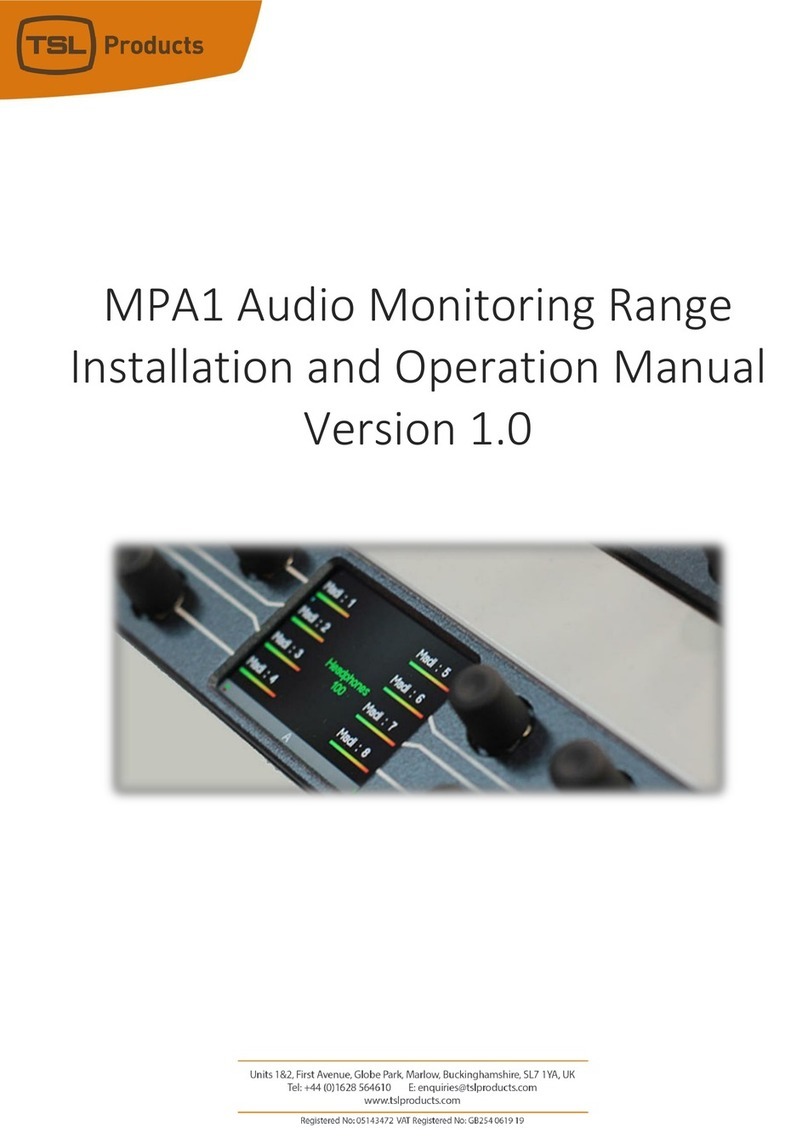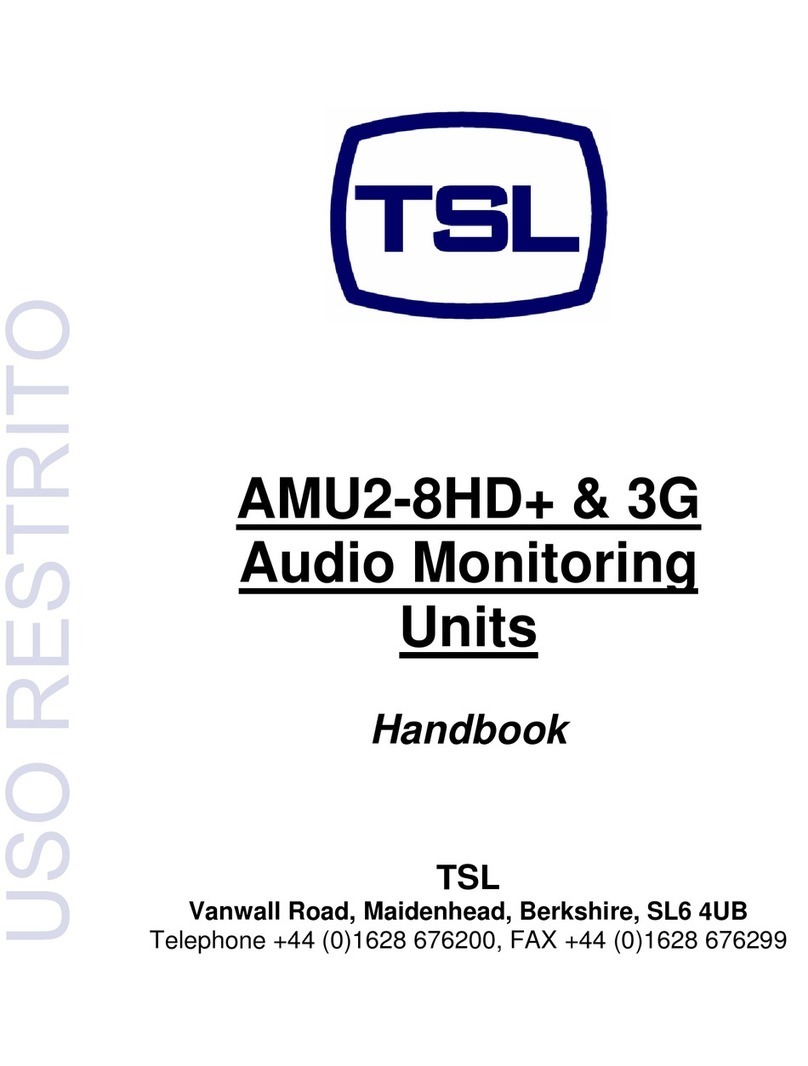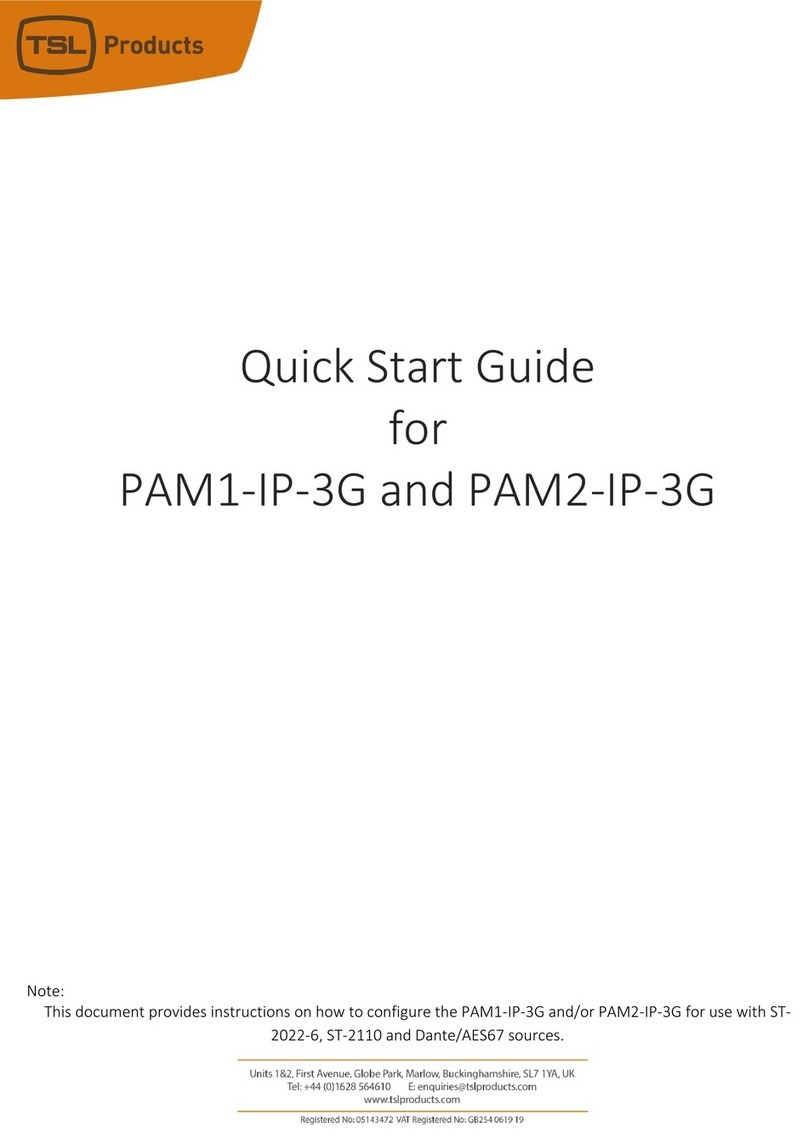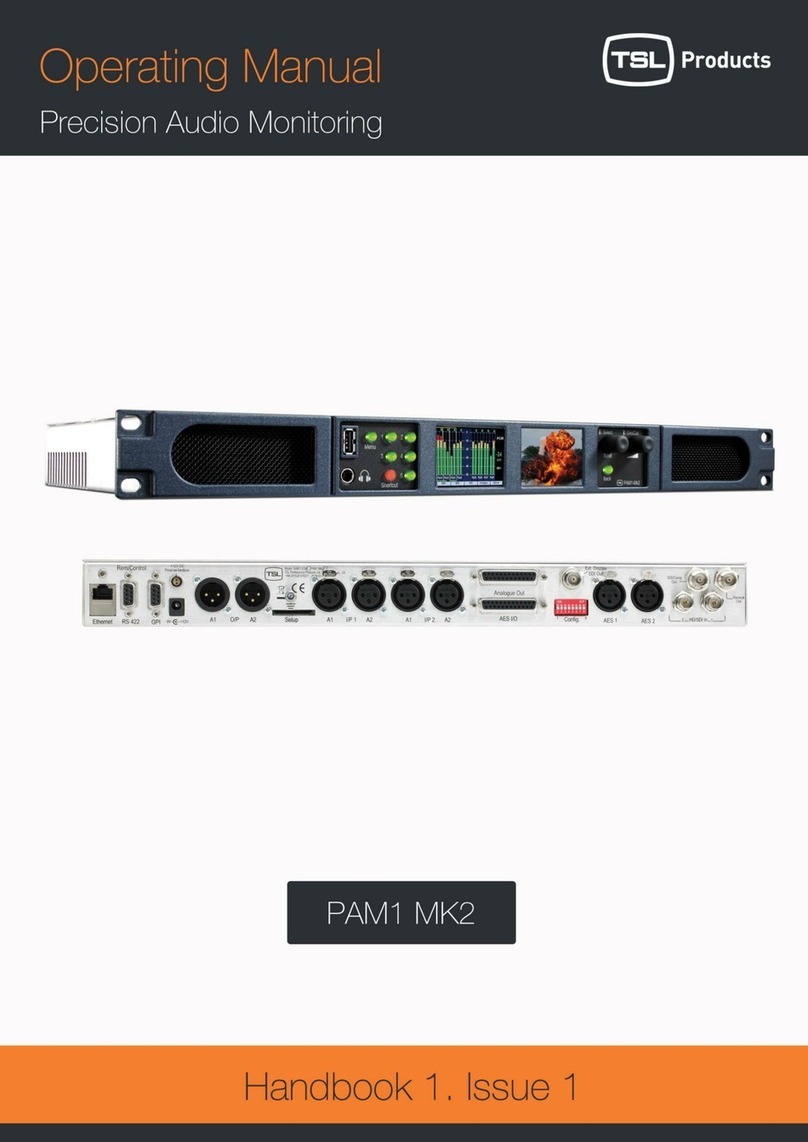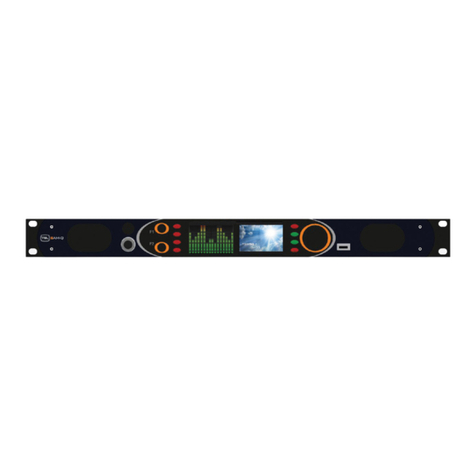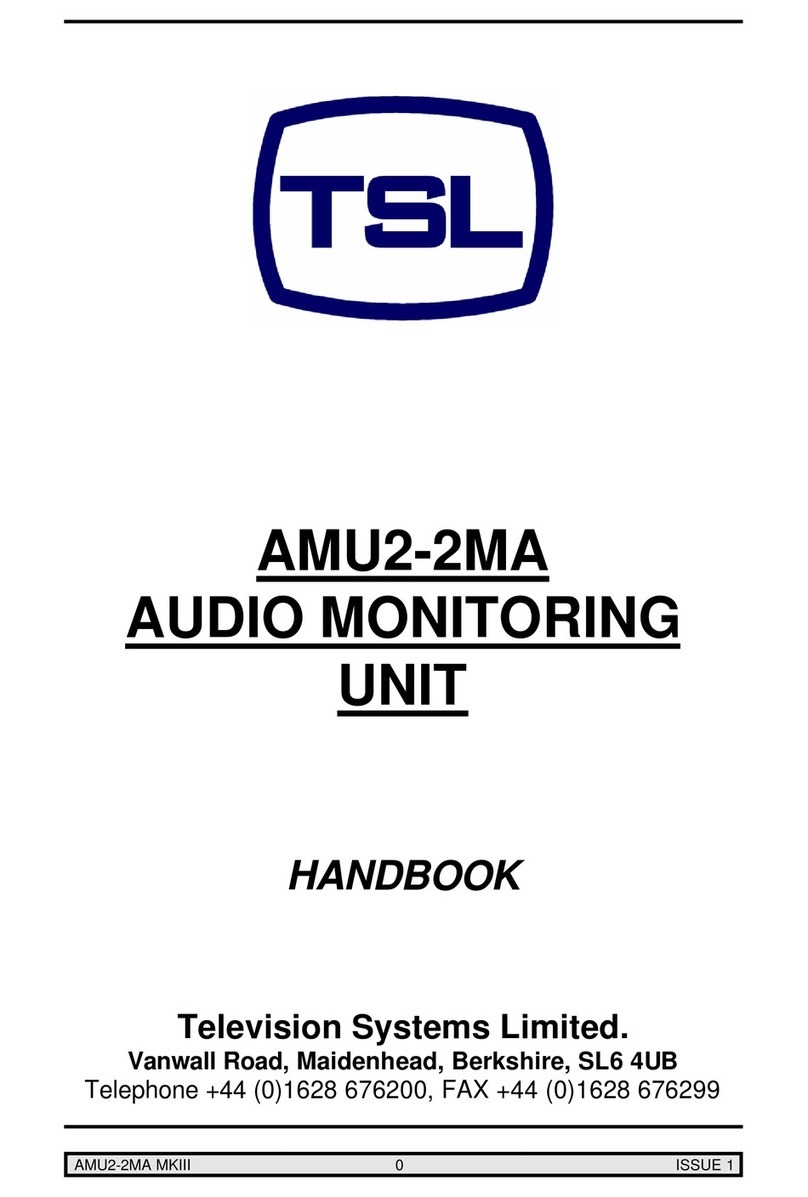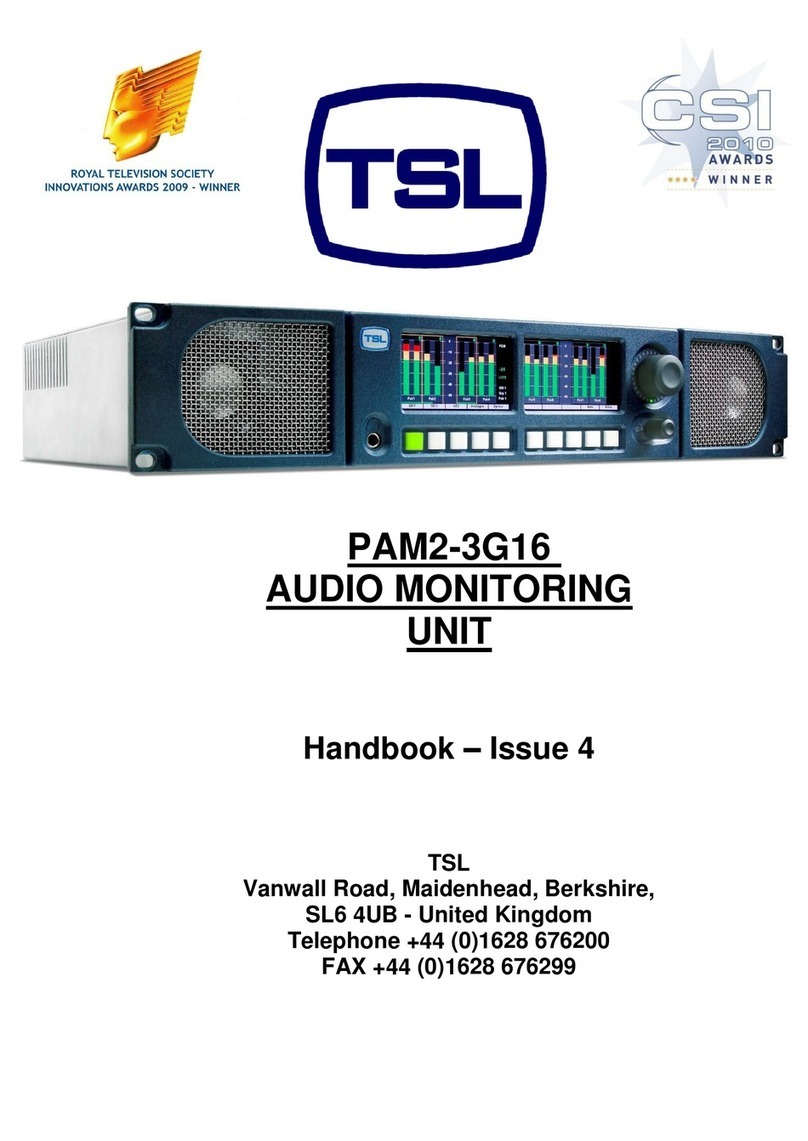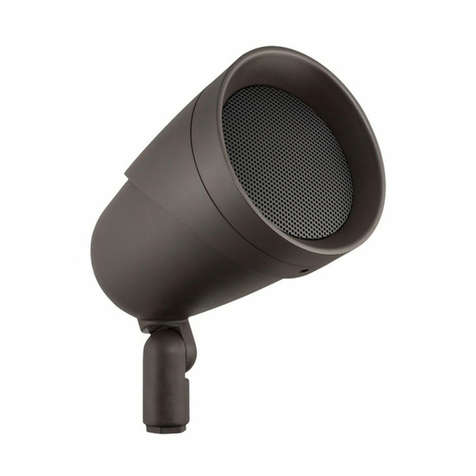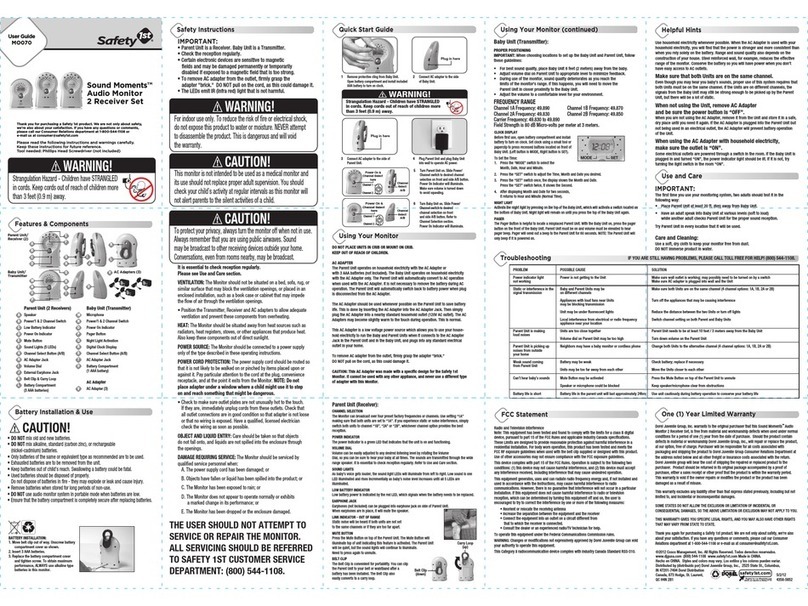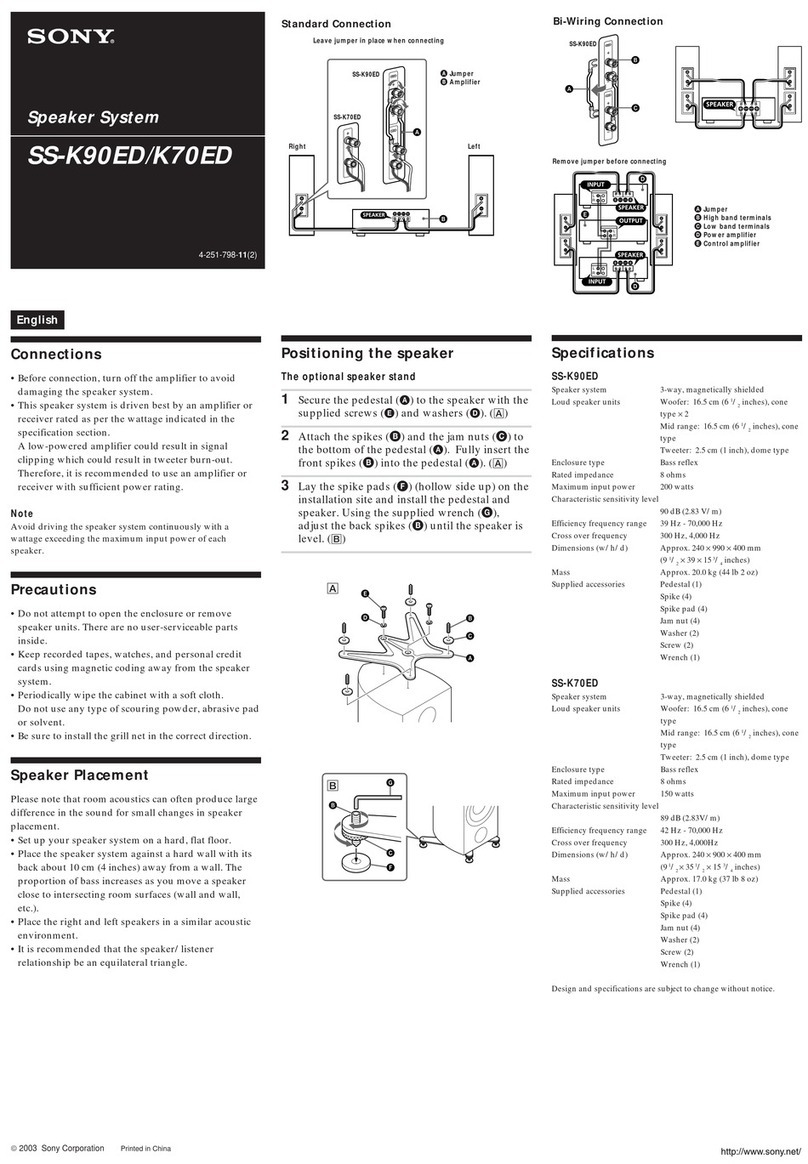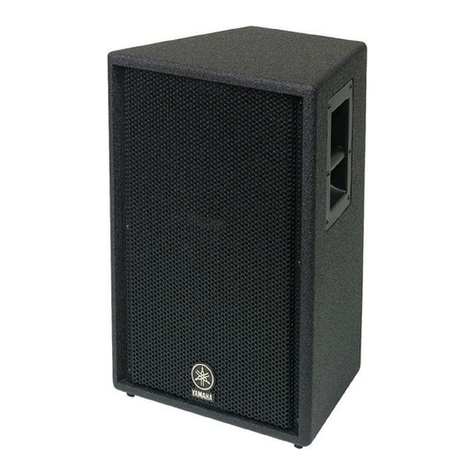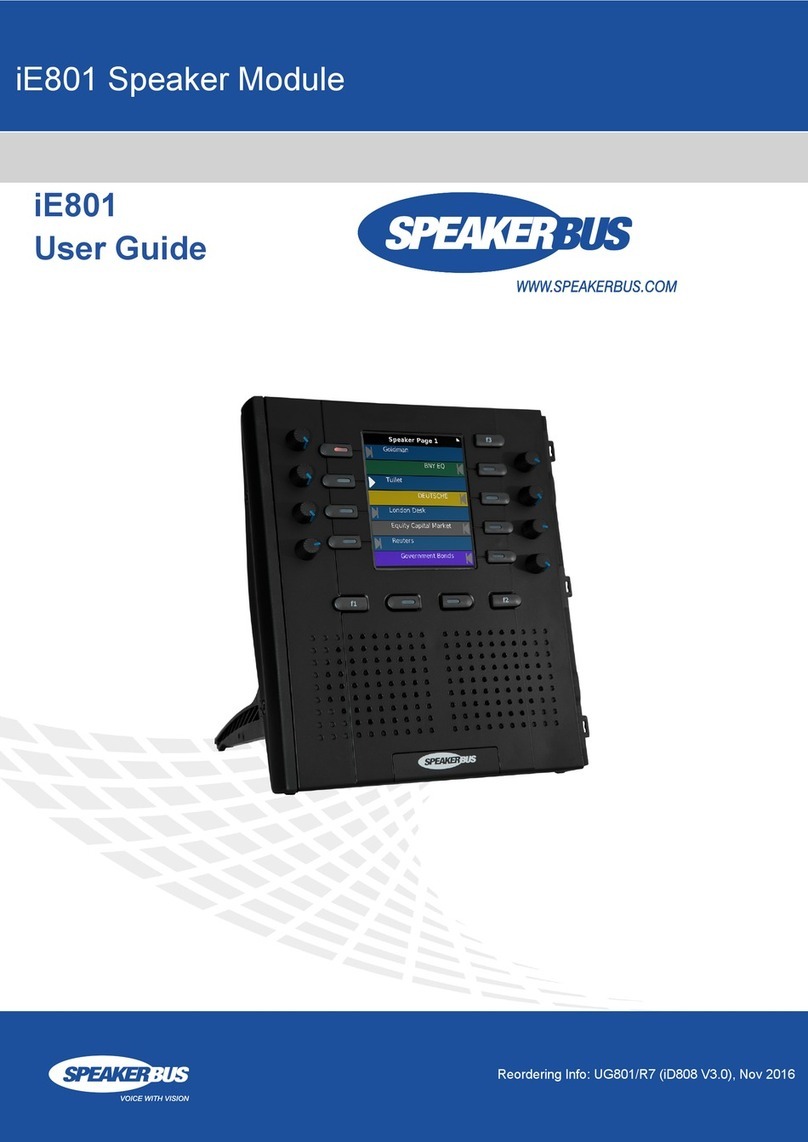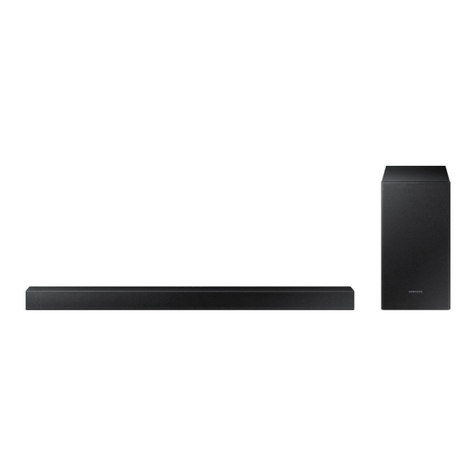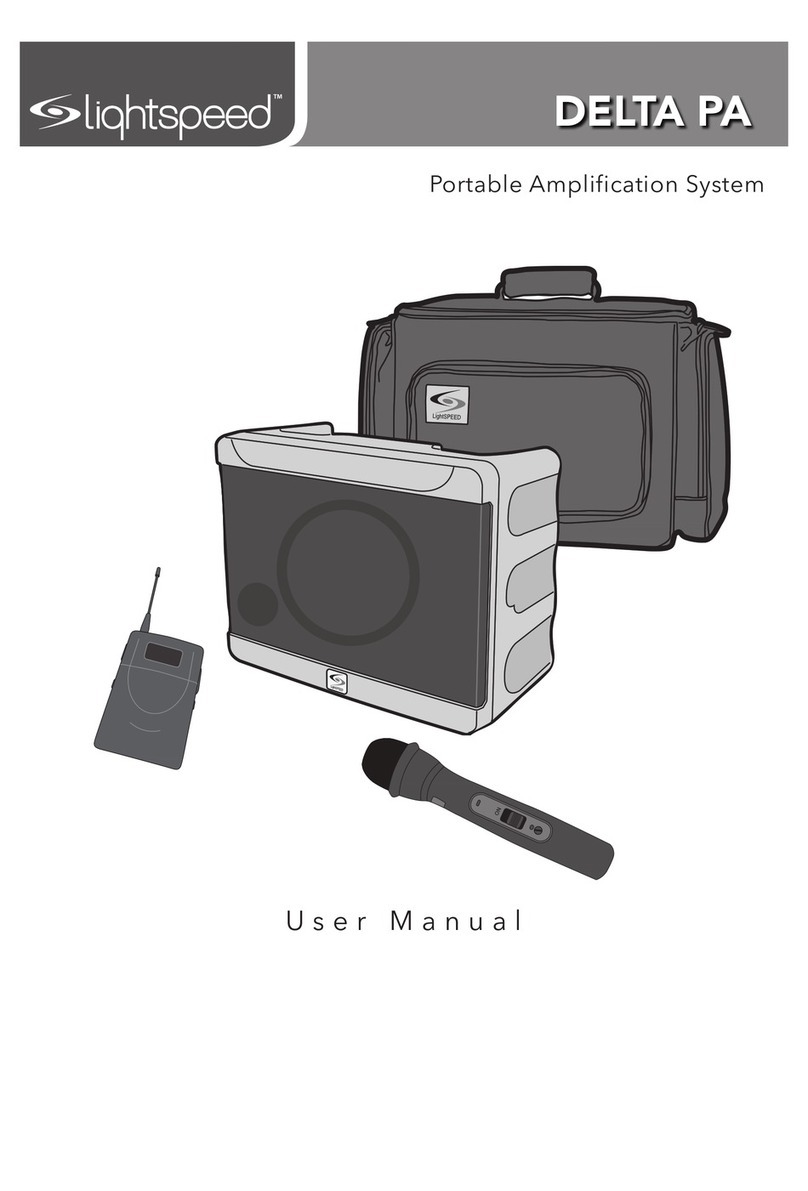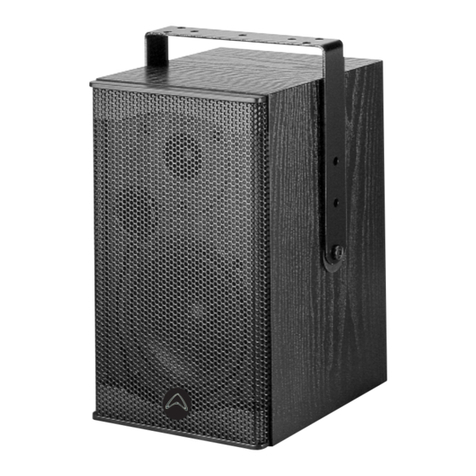TSL TOUCHMIX (AVM-T-MIX) User manual


P a g e | 2
AVM-T-MIX User Handbook Version Three
SAFETY
Installation.
Unless otherwise stated TSL equipment may be installed at any angle or position within an
-
All TSL equipment conforms to the EC Low Voltage Directive:
EC Low Voltage Directive (73/23/EEC)(OJ L76 26.3.73)(LVD).
Amendment: (93/68/EEC) (OJ L220 30.8.93).
In all cases the frame of the equipment must be earthed on installation.
Where appropriate, the earth pin on the IEC mains inlet connector is connected to the metal frame
of the equipment, to 0 volts on the internal DC PSU and to signal ground unless otherwise stated.
All metal panels are bonded together.
Check that the voltage selector setting (if fitted) and the fuse rating is correct for the local mains
supply.
Due consideration for cooling requirements must be given when mounting the equipment. It is
recommended that a 1RU of rack space, or a vent panel, should be left above and below the unit.

P a g e | 3
AVM-T-MIX User Handbook Version Three
WARRANTY, MAINTENANCE AND REPAIR
All TSL products have a one year warranty period starting from the date it
leaves the factory.
A repair warranty is to apply. That is, the product is to be returned for
repair with no replacement and an exchange shipping policy is also to apply.
TSL offers a seven day DOA policy together with an exchange shipping
policy. That is, if a product has been declared ‘dead on arrival’ within a seven day period a
warranty replacement will be shipped.
A temporary replacement may be available where, for operational
reasons, it is imperative that service is continued. The customer will be asked to enter into
a ‘loan agreement’ for the duration of repair.
All faulty equipment returned to TSL for repair will, where possible, be
returned to the customer within seven working days.
TSL Returns Procedure
Please telephone +44 (0)1628 676221 (Fax: +44 (0)1682 676299) and ask for Customer
Support, detailing the model and serial number of the equipment, who will provide a Returns
Number. This will enable us to track the unit effectively and will provide some information prior to
the unit arriving.
For each item, this unique Returns Number must be included with the Fault Report sent
with the unit.
A contact name and telephone number are also required with the Fault Report sent with
the unit.
Fault report details required.
Company:
Name:
Address:
Contact Name:
Telephone number:
Fax number:
Email address:
Returns Number:
Symptoms of the fault (to include switch setting positions, input signals etc):
Packing
Please ensure that the unit is well packed as all mechanical damage is chargeable. TSL
recommends that you insure your equipment for transit damage.
The original packaging, when available, should always be used when returning equipment.
If returned equipment is received in a damaged condition, the damage should be
reported both to TSL and the carrier immediately.

P a g e | 4
AVM-T-MIX User Handbook Version Three
This Page is Blank

P a g e | 5
AVM-T-MIX User Handbook Version Three
Table of Contents
1.0 Introduction............................................................................................................................ 7
1.1 Block Diagram ....................................................................................................................... 9
1.2 Operation............................................................................................................................. 10
2.0 Controls and Displays - Overview........................................................................................ 11
2.1 Source Selection..................................................................................................................14
2.2 Analogue Audio Input Trim..................................................................................................15
2.3 Channel Signal Format Selection –Stereo Mix/Mon Modes...............................................16
2.3.1 Stereo Channel Format: .............................................................................................. 16
2.3.2 Mono Channel Format:................................................................................................ 16
2.3.3 Group Channel Format:............................................................................................... 16
2.3.4 Group 2 PAIR ADD:.....................................................................................................16
2.3.5 Group 2 PAIR OFF:.....................................................................................................16
2.3.6 Group 5.1 DMIX:.......................................................................................................... 16
2.3.7 Group LRC DMIX:........................................................................................................ 17
2.4 Channel Signal Format Selection –Surround Sound Mix/Mon Modes ...............................17
2.4.1 Stereo Channel Format: .............................................................................................. 17
2.4.2 Mono Channel Format:................................................................................................ 17
2.4.3 Group Channel Format:...............................................................................................18
2.4.4 Group 5.1 ALL: ............................................................................................................18
2.5 Monitoring Input Channels –Solo Function......................................................................... 19
2.6 Monitoring Input Channels –Mixer Function....................................................................... 20
2.7 Audio Mixers 1 and 2...........................................................................................................21
2.7.1 Switching Audio Mixer 1 to 5.1 mode ..........................................................................21
2.8 Configuring and Naming Input Channels............................................................................. 22
2.9 X-Y Routing .........................................................................................................................23
2.9.1 XY Routing Setup........................................................................................................ 23
2.9.2 Internal Sources........................................................................................................... 25
2.9.3 Physical Sources .........................................................................................................26
2.9.4 Choosing the active SDI input .....................................................................................26
2.9.5 Physical Outputs..........................................................................................................26
2.9.6 Routing Status ‘Window’..............................................................................................27
2.9.7 Overview Menu Page ..................................................................................................27
2.9.8 Conditional Routing Rules ...........................................................................................28
2.9.9 Lock and Unlock Selection.......................................................................................... 28
2.9.10 Set as Default.............................................................................................................. 28
2.10 Routing System XY Crosspoint Map ................................................................................... 29
2.11 User Preset and Snapshot Management ............................................................................ 30
2.11.1 Home Button and User Presets...................................................................................30
2.11.2 User Presets –SAVE Menu ........................................................................................30
2.11.3 User Presets –Recall Menu........................................................................................ 32
2.12 Setup Menu .........................................................................................................................33
2.12.1 Meter Menu.................................................................................................................. 33
2.12.2 dBFs Menu ..................................................................................................................34
2.12.3 Meter Peak Menu ........................................................................................................ 34
2.12.4 Meter Zero Menu......................................................................................................... 34
2.12.5 Meter Hold Menu......................................................................................................... 35
2.12.6 SDI Input Select........................................................................................................... 35
2.12.7 Mixer 1 Mode............................................................................................................... 35
2.12.8 Output Menu................................................................................................................ 35
2.13 Setup 2 Menu ......................................................................................................................36
2.13.1 User Save Menu.......................................................................................................... 36
2.13.2 Monitor Mode............................................................................................................... 36
2.13.3 GPI Menu..................................................................................................................... 37
2.13.4 Internal / External Loudspeaker Mute.......................................................................... 37
2.13.5 Surround Mix Menu .....................................................................................................38
2.14 Software Menu..................................................................................................................... 38
3.0 Connectivity and pin-out details...........................................................................................40
3.1 Analogue XLR Connectors –Stereo Variable Output (Monitor Buss)................................. 40
3.2 Analogue Output Connector................................................................................................ 41
3.3 Analogue Input Connectors 1-4 and 5-8 –........................................................................... 42
3.4 AES Input/Output Connectors 1-4 and 5-8..........................................................................43

P a g e | 6
AVM-T-MIX User Handbook Version Three
3.5 GPI Connector –HD15 Socket............................................................................................ 44
3.6 Remote Control Connector/ RS 422 - D9 Socket................................................................ 44
3.7 DIP switch configuration functions –To be confirmed ........................................................44
4.0 Notes ...................................................................................................................................45
4.1 General Notes......................................................................................................................46
5.0 AVM TOUCH SERIES - Technical Specifications............................................................... 46
5.1 HD Standards Supported.....................................................................................................47
5.2 Performance........................................................................................................................47
6.0 Installed HDC-2T Audio Monitor Module Specification........................................................ 48
6.1.1 Overview...................................................................................................................... 48
6.1.2 Mechanical................................................................................................................... 48
6.1.3 Power...........................................................................................................................48
6.1.4 Inputs...........................................................................................................................48
6.1.5 Outputs........................................................................................................................ 48
6.1.6 Loudspeakers.............................................................................................................. 49
6.1.7 GPI inputs.................................................................................................................... 49
6.1.8 Control......................................................................................................................... 49

P a g e | 7
AVM-T-MIX User Handbook Version Three
1.0 Introduction
AVM-T-MIX is the world’s first rackmount Touchscreen controlled audio monitor unit. The Touch-
Mix system delivers a unique combination of audio monitoring and channel mixing capabilities
designed to simplify operations and workflow throughout the Television broadcast environment.
The AVM-T-MIX is a 2RU x 320mm Audio Mixer/Monitoring Unit controlled via a touch screen
interface and assignable hardware controls.
As with any new product which relies on complex software, it is possible that you may find minor
bugs or perhaps think of enhancements which would improve the operation of AVM-T-MIX. In the
event of either scenario, please feel free to contact TSL via your local reseller or directly on +44
1628-676221, asking for the TOUCH SERIES Product Manager.
TSL will be releasing upgrades and feature enhancements from time to time –as a purchaser of
AVM-T-MIX you should receive these directly, free of charge, through your reseller or directly from
TSL. Please refer to www.tslproducts.com for announcements.
The following features are standard:
Single or Dual (SD Only) Auto-sensing, 1080p (60, 59, 94 and 50Hz), HD/SDI video input
De-embedded audio monitoring from video (HD/SDI) with intuitive selection from up to
sixteen channels (SDI 1 only), and eight channels (SDI 2 Group 1 and 2 only)
8 AES (8 Pairs/16 Channel) and 4 AES (4 Pairs/8 Channel –SD Only) Inputs–110Ohm
Balanced or 75 Ohm unbalanced via optional CAB-D25-BNC cable
8 Analogue Stereo Inputs
Identical twin audio mixers
10 stereo/ 20 dual mono assignable input channels per mixer
5.1 audio mixing and monitoring capability
Full input / output XY routing function
Surround Sound Speaker Output Support
Downmix of discrete multichannel audio to stereo for compatibility monitoring
Re-clocked HD/SDI video output.
Choice of user selectable bargraph scales (BBC PPM, EBU PPM, EBU Digital, Nordic, VU
and DIN)
18 User programmable presets.
‘Home’ button for instant recall of default operating condition
Manage, recall and save favourite configurations via USB stick or SD card
Fixed or variable analogue stereo outputs (mixer 1 and 2)
Fixed or variable AES stereo outputs (mixer 1 and 2)
Variable stereo analogue outputs (Monitor Buss)
High quality internal full range loudspeaker system
Dual 12V DC inputs
Serial remote control
Headphone output with LS muting
Compact, lightweight (5.1Kg) 2RU case, 320mm deep

P a g e | 8
AVM-T-MIX User Handbook Version Three

P a g e | 9
AVM-T-MIX User Handbook Version Three
1.1 Block Diagram

P a g e | 10
AVM-T-MIX User Handbook Version Three
1.2 Operation
The AVM-T-MIX is designed to be user friendly and intuitive to operate. The menus and functions
will feel familiar to both users of TSL multichannel audio monitoring products and those buying a
TSL solution for the first time.
Important Note: AVM-T-MIX ships with a default 0dBu reference level set to
-18 dBFS, the default operating scale is EBU Digital. The operational reference level for the
unit can easily be changed via the Setup menu (described elsewhere in this handbook).

P a g e | 11
AVM-T-MIX User Handbook Version Three
2.0 Controls and Displays - Overview
.
CLEAN
LCR
Dmix
Rst Lvl
Mono
Stereo
FX LIVE
MIC1 OB
COMMS PGM
L R
ST.
PGM PGM
C LFE PGM
LS RS OFF
AIR
AES
MON NO
INPUT MSTR
0
10
20
30
40
50
Rst Bal
Setup
SDI 1 pair 1
Solo
LCR DMIX
Send: 0.0dB
Bal: L = R
MIX 1
Cut Cut Cut Cut Cut Cut Cut Cut Cut Cut
AVM-T-MIX is equipped with a 4 driver loudspeaker system comprising left/right tweeter
and dual subwoofer units.
Menus and features are navigated via the 22:9 aspect ratio touch screen.
The front panel USB connector is used for software upgrades; favourite user preset
storage and preset recall.
User presets can be recalled and stored locally using the ‘Home’ button.
Loudspeaker and headphone volume is adjusted by the master level control. This dual
action rotary encoder also features push to Cut/Dim functionality.
The dual function rotary encoder is rotated to control channel level ‘send’ with pan/balance
activated by push and turn.
Dual Action Monitoring
Level Control w/Cut, Dim
Dual Function
Encoder –Level
Send/Push for
Pan/Balance
4-Driver
Loudspeaker
System
USB Port for Field
Upgrades and
System Backup
‘Home’ Preset
Instant Recall
22:9 Aspect
Ratio LCD
Touch Screen

P a g e | 12
AVM-T-MIX User Handbook Version Three
Touch and Hold channel bargraph to activate input selection menu.
Upon selection of input, selected channel format is selected via the Stereo/Mono/Group
buttons.
Selected channel gain and Bal/Pan level indicated by icons below bargraph display.
Stereo/Mono/Group channel format denoted by colour of level send control and ‘pips’
beneath bargraph pairs.
Individual channels can be ‘cut’ from main mix buss.
Individual channels can be ‘soloed’ to monitoring output buss.
AVM-T-MIX features two entirely independent Audio Mixers. Touch and Hold Mix Master
Bargraph to toggle between Mixer 1 and Mixer 2.
Mixer 1 can be configured for stereo and 5.1 outputs
Touch and Hold
Bargraph for
Source Selection
Input Channel
Format Selection
Level Send and
Bal/Pan
Indication
Selected Channel
Status and ‘Solo’
Button
Individual
Channel ‘Cut’
Switch
Stereo/Mono/Group
Channel Status
Touch and Hold Mix Master
Bargraph to Select Mix 1 or
Mix 2 Input configurations

P a g e | 13
AVM-T-MIX User Handbook Version Three
Input sources named with a user defined 10 character mnemonic displayed above the
channel bargraph.
Unused input channels can be routed to ‘Silence’ displayed as ‘No Input’.
Channel Group format is denoted by use of Magenta or Yellow colouration.
Channel Group formats include ‘2 Pair’, ‘5.1 Downmix’, ‘LRC Downmix’ (as shown above)
and ‘5.1 ALL’.
Channel Stereo format is denoted by use of Electric Blue or Silver colouration.
Channel Mono format is denoted by use of Cyan colouration.
Channel Mono formats include ‘L+R, ‘Left to both’ and ‘Right to both’ (as shown above).
Selected Channel status shown in information ‘box’ includes ‘Source’, ‘Format’, ‘Send
level’ and ‘Bal/Pan adjustment’.
Input Channels
with 10 Character
User Mnemonic
Names
Unused Input
Channels Routed
to ‘No Input’
Names
Channels defined as
Group in either ‘2 Pair’,
‘5.1’ or ‘LRC’ formats
Channel defined as ‘Mono’,
‘Left Only’ or ‘Right Only’
formats
Channel defined
as Stereo format
Selected Channel overview
including ‘Input Source’,
‘Format’, ‘Send level’ and
‘Bal/Pan’

P a g e | 14
AVM-T-MIX User Handbook Version Three
2.1 Source Selection
Key to the ease of operation of AVM-T-MIX is the simplicity by which audio may be monitored
and/or mixed. As described previously, AVM-T-MIX is equipped with two completely independent
mixer/monitor systems (Mixer 1 and Mixer 2). Each can be configured with its own setup and used
in diverse applications.
Mixer 1 may be used as primary audio monitor in any application whilst the secondary mixer might
be used as a simple de-embedder to ‘back-feed’ another part of the system or even as a means to
derive a headphone cue to a voice over artist or commentator.
Setting up the monitor for use is simple and intuitive yet incredibly powerful.
AVM-T-MIX Source Selection
AVM-T-MIX SD Source Selection
By simply touching and holding the desired channel the ‘SOURCE’ menu selection is
automatically activated. Select the signal type/pair or ‘SILENCE’ if no selection is required
and the chosen audio will be routed to the channel pair.
If the selected input has been configured with a User Name then the text string will be
displayed above the bargraph pair.
Audio is automatically routed to the selected channel from an active input and the signal
activity displayed on the bargraph. To hear the incoming audio instantly, simply press
SOLO and turn up the volume.
Touch ‘BACK’ to exit the ‘SOURCE’ menu.

P a g e | 15
AVM-T-MIX User Handbook Version Three
2.2 Analogue Audio Input Trim
AVM-T-MIX is designed to be used with balanced or unbalanced analogue audio inputs. If one of
the analogue inputs has been wired to an unbalanced signal source then the user may need to
compensate for signal loss (typically -6dB). If this is the case then gain can be added to the chosen
analogue input in steps of 3dB by touching the button displayed below via the Setup/Input menu.
Please note that the AVM-T-MIX does not have an analogue signal amplifier and that the gain is
added in the digital domain. If gain is added to an unbalance analogue audio input in this way then
the signal to noise ratio of that signal will be affected accordingly and low level ‘hiss’ may be heard
in exceptional circumstances.
Press to access Input
Trim for low level or
unbalanced analogue
audio

P a g e | 16
AVM-T-MIX User Handbook Version Three
2.3 Channel Signal Format Selection –Stereo Mix/Mon Modes
Applicable to Stereo Output Mixer Formats Only
Channel formats can be defined as Stereo,
Mono or a Group of 2 or more pairs (including
5.1 and LRC Downmix configurations).
2.3.1 Stereo Channel Format:
To define a channel as Stereo, simply touch the
desired bargraph pair followed by the ‘STEREO’
button from the Format menu (as shown).
The Level Send and format ‘Pips’ below the
bargraphs denote Stereo selection by the use of
Electric Blue colouration
2.3.2 Mono Channel Format:
To define a channel as Mono, simply touch the
desired bargraph pair followed by the ‘MONO’
button from the Format menu (as shown). The
MONO L/R menu is then activated enabling the
operator to choose between ‘Mono (L+R)’, ‘Left
(to Both)’ and ‘Right (to Both)’ formats.
Using the latest available software for the AVM-
T-MIX standard unit, only the chosen or
resultant audio bargraph is represented
The Level Send and format ‘Pips’ below the
bargraphs denote Mono format selection by the
use of Cyan colouration
2.3.3 Group Channel Format:
There are four modes of selection within the
GROUP menu designed to enable the user to
mix and monitor sources delivered in more
complex channel formats.
2.3.4 Group 2 PAIR ADD:
2 Pair Additive mode sums two adjacent stereo
audio pairs together in the format L+L and
R+R. The user can adjust the level of the left
sum against right via the balance control.
2.3.5 Group 2 PAIR OFF:
2 Pair Offset mode sums two adjacent stereo audio pairs together in the format L+L and
R+R however unlike the 2 PAIR ADD mode, the balance control is used to adjust the
relative mix of Pair One against Pair Two.
Pair Offset mode is particularly useful for adjusting the balance of monitored audio when
source material comprises a clean FX track on pair one and a commentary on pair two as
is often common in Sports Broadcasting.
2.3.6 Group 5.1 DMIX:
5.1 Downmix mode sums 3 adjacent pairs in an Lo Ro stereo format assuming that a
standard 5.1 configuration track order has been adhered to (L/R/C/LFE/Ls/Rs) as shown in

P a g e | 17
AVM-T-MIX User Handbook Version Three
the image above. In 5.1 Downmix mode the LFE channel does not form part of the stereo
sum. The user can adjust the level of the left sum against right via the balance control.
The 5.1 Downmix algorithm follows the formula L+(C-3dB) + (Ls-3dB), R+(C-3dB) + (Rs-
3dB).
A user selectable adjustment located within the menu Setup/Setup2/DMIX enables
selection of the a ‘Surround -6dB) coefficient with the resultant formula
L+(C-3dB) + (Ls-6dB), R+(C-3dB) + (Rs-6dB) active depending on the selection.
2.3.7 Group LRC DMIX:
LRC Downmix mode sums 2 adjacent pairs together as a stereo signal with the first
channel of the second pair summed equally to the Left/Right channels. The user can adjust
the level of the left sum against right via the balance control.
The LRC Downmix algorithm follows the formula L+(C-3dB), R+(C-3dB)
The Level Send and format ‘Pips’ below the bargraphs denote a Group format selection by
the use of Magenta colouration
2.4 Channel Signal Format Selection –Surround Sound Mix/Mon Modes
Applicable to 5.1 Output Mixer Formats (see section 2.7.1)
When Mixer One is set to 5.1, additional channel format selections can be made in order to
route 5.1, stereo and mono signals to the appropriate surround sound output channels
2.4.1 Stereo Channel Format:
When operating with Mixer One set to 5.1, an
extended format selection option appears within
stereo channel format options. The operator
can choose by touch to route a stereo pair to
either the front or rear stereo left and right
channels
In the example shown you can see how SDI1
pair 9 is routed to the front left and right
channels and SDI pair 10 to the surround left
and right channels respectively. Front channel
routing is denoted by the Electric Blue or
colour and rear channel routing, by the Silver
colour.
2.4.2 Mono Channel Format:
When working on a 5.1 project a mono channel
selection enables the user to route mono audio
to anywhere across the image of the front
speakers (left, centre, right). This is achieved
using a divergence control that appears within a
mono mode adjacent to the left right panner.
In the example shown the mono channel
selection routes a chosen signal to the centre
mix channel only and the divergence (denoted
D:C) is highlighted in yellow and set to zero. By
pressing the encoder, the operator can toggle
between gain, pan and divergence controls
which can then be adjusted to vary the signal level sent to the centre, left and right
channels respectively thus providing complete control over the mono image across all
three channels.

P a g e | 18
AVM-T-MIX User Handbook Version Three
2.4.3 Group Channel Format:
The four modes previously described for stereo mixer use (2 pair ADD, 2 pair OFF, 5.1
DMIX and LRC DMIX) remain active when a 5.1
mixer mode is activated however an additional
mode, 5.1 ALL, now appears under the
Grouping menu.
2.4.4 Group 5.1 ALL:
The 5.1 ALL mode is used to define a group of
signals that represent a 5.1 programme and
route them in order to the 5.1 mixer channel
output as shown in the image adjacent. A 5.1
ALL group when selected is represented by the
Yellow colour of the menu button and gain
control icon.
In this mode it is assumed that the audio
channels are presented in the order Left, Right, Centre, LFE, Left Surround, and Right
Surround and are routed to the mixer accordingly.

P a g e | 19
AVM-T-MIX User Handbook Version Three
2.5 Monitoring Input Channels –Solo Function
Similar to a traditional rackmount audio monitoring unit, the AVM-T-MIX is used to listen to
incoming signal sources –either exclusively or additively. The simplest way to achieve this is to
touch the bargraph channel you wish to hear and then to select SOLO.
The selected signal will automatically be routed to the loudspeakers (internal or external) and to
the headphone socket.
The example above shows how an operator can quickly check an incoming Programme
audio signal which has been Downmixed to stereo from 5.1. In SOLO Mode. He/she
can now simply touch the adjacent 5.1 bargraph group labelled PGM2 in order to
compare the two signals or alternatively touch the SOLO buttons beneath another
bargraph pair to add the signals to the monitoring output.
The selected SOLO channels are automatically routed at unity gain to the output as
denoted by the position of the rotary SEND icon.
In SOLO mode, any MIXER routing configurations on either MIXER 1 or MIXER 2 are
unaffected.
When MIXER 1 is configured as 5.1 the SOLO function will automatically downmix any
selected channels to the internal stereo speakers or route a defined 5.1 channel group
to the 5.1 external speaker if used.

P a g e | 20
AVM-T-MIX User Handbook Version Three
2.6 Monitoring Input Channels –Mixer Function
One of the unique advantages of AVM-T-MIX over a more traditional Audio Monitoring Unit is
the ability to mix sources together using the same methods found in assignable digital audio
mixing consoles. Mixer 1 and Mixer 2 are both equipped with main outputs which are routed to
the monitoring outputs (loudspeakers and headphones) and to fixed line level Analogue and
AES connections.
Individual bargraph channels can be mixed onto Master Output bargraphs by adjusting the send
level of the selected (highlighted by the yellow ‘box’) channel using the small rotary encoder
simply by turning it clockwise. By pushing and turning the encoder it is possible to adjust the
Balance (for Stereo and Downmixed sources) or Pan (Mono) of the selected output being sent
to the Mixer Master output.
The example above depicts a typical Lines Room application where the operator is
monitoring 3 different incoming language feeds as LRC Downmixes embedded within
the SDI infrastructure on channels 1 thru 6. He/She is simultaneously listening to audio
traffic via an AES router (channels 7 and 8) of Stereo Telco feeds 1 and 2 from another
location plus a mix of local and remote mono Talkback on channels 9 and 10.
The Talkback inputs from the Outside Broadcast and local Studio are panned to the
left and right channels respectively to give separation against the Clean/Native
Language Downmix coming from the OB event.
Channels 3 and 4 plus channels 5 and 6 contain Clean/Alternative Language
Downmixes which are being generated locally from Voice Over Booths with French
and German Commentators.
Mixer 2 line level outputs can be used in this application to provide a Submix of the
Clean International Audio plus Local and OB Talkback to the Commentators via their
local headphone amplifiers.
Mixer 1 can be configured to operate in 5.1 mode. When selected via the setup menu
Setup/Mixer/Surround the main output of Mixer 1 comprises a full 5.1 buss structure
of Left/Right/Centre/LFE/Left Surround/Right Surround that can be used for
external monitoring (via externally connected surround sound speakers) and also
delivers a fixed level 5.1 mixer output to both analogue and AES output connections
Even when Mixer 1 is configured for 5.1 use a parallel stereo version of the mixer runs
as a background application and can be used as an alternative auto-downmixed output
or for stereo monitoring (including internal and headphone outputs on the T-MIX itself).
Table of contents
Other TSL Speakers System manuals
Popular Speakers System manuals by other brands
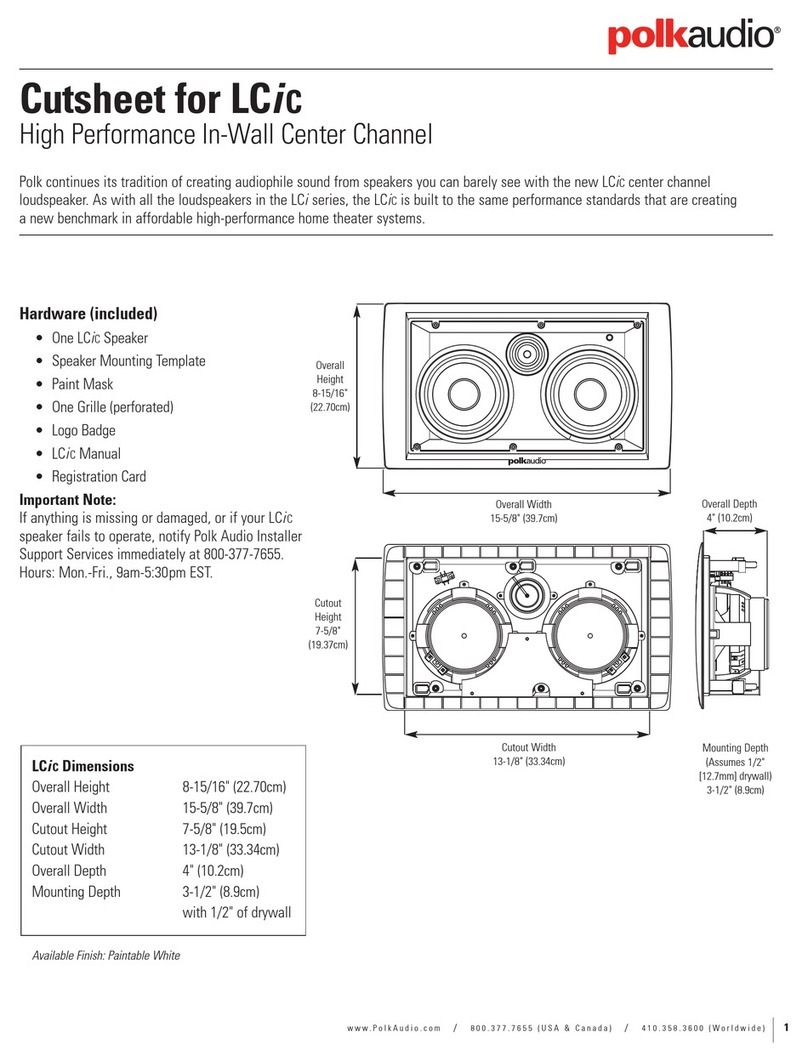
Polk Audio
Polk Audio High Performance In-Wall Center Channel Specification sheet
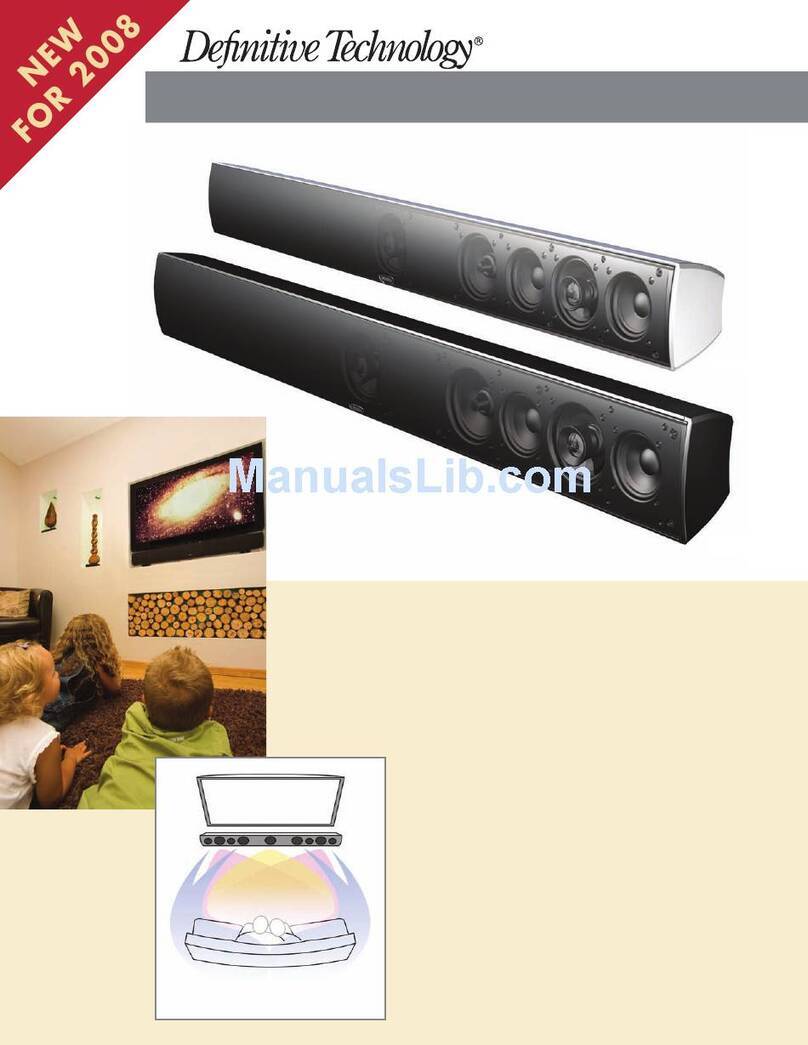
Definitive Technology
Definitive Technology Mythos SSA-42 Specifications
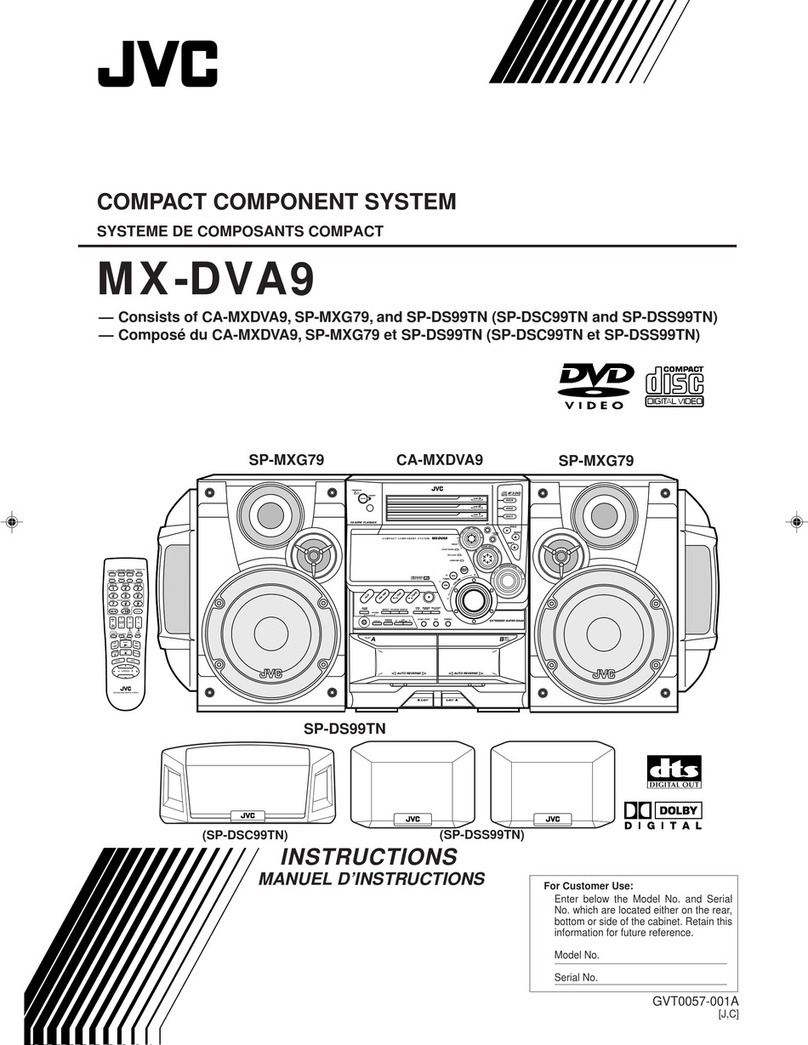
JVC
JVC MX-DVA9 instructions

Atlantic Technology
Atlantic Technology Atlantic FS-4000 Product information sheet
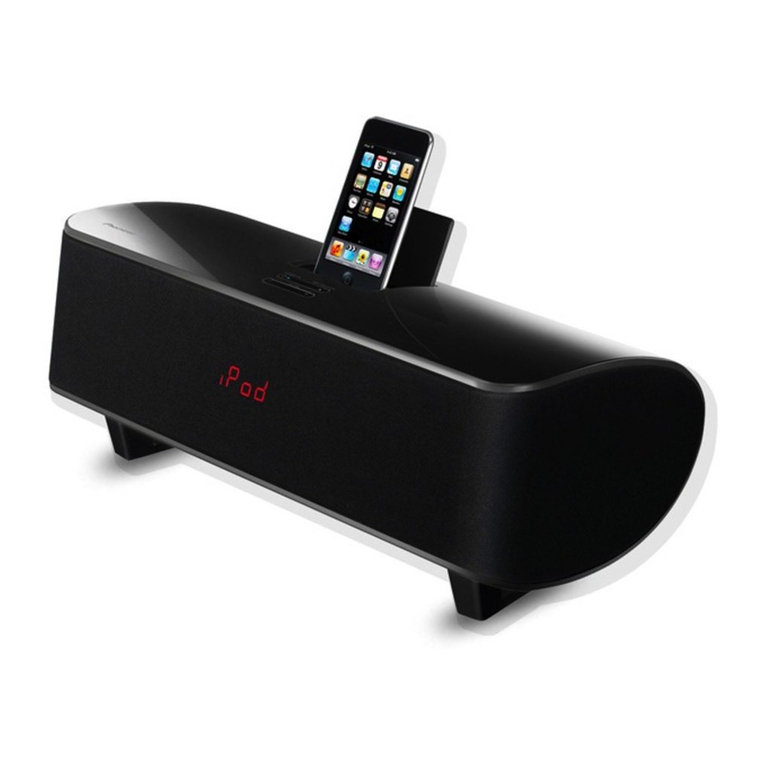
Pioneer
Pioneer XW-NAS5 operating instructions
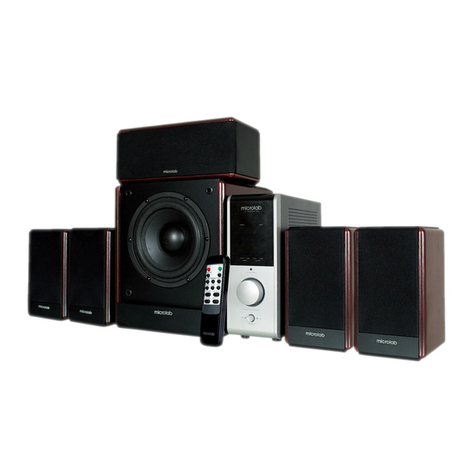
Microlab
Microlab FC730 user manual
